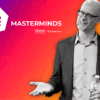
The CHRO’s Guide: When Talent Strategy, People Analytics & Business Results come together
today2023.07.26. 554

WHY SHOULD YOU CARE?
“HR is not about HR” (Dave Ulrich) – Understand how CHROs are impacting and driving business outcome through by embracing data-driven talent strategies and people analytics. Learn how these groundbreaking approaches are not only reshaping HR functions but also driving organizational success, bridging the people impact gap, and transforming your business’s competitive advantage
In the corporate landscape of today, the role of Chief Human Resources Officer (CHRO) is at a pivotal moment. Traditionally, HR’s value has been associated with managing costs and mitigating risks, but a paradigm shift is underway. Increasingly, CHROs are recognized as catalysts for driving productivity, effectiveness, and overall impact within organizations. As businesses seek to bridge the “people impact gap,” HR leaders must look beyond siloed specialties and embrace a business-first approach to tackle systemic challenges effectively.
In this pursuit, the integration of Talent Strategy, People Analytics, and Business Results has emerged as a winning formula. Forward-thinking CHROs are leveraging People Analytics to empower decision-makers outside of HR, enabling them to make better-informed choices. Just as CFOs play a critical role in financial strategy, CHROs are being tasked with elevating talent strategy and infusing data-driven insights into every facet of the organization.
The message from industry experts is clear – competitive advantage in the coming years will stem not from merely understanding customers, but from understanding people. As Paul Rubenstein, Chief People Officer of Visier, emphasizes, the winners and losers in this new era will be distinguished by their ability to define and execute a proper talent strategy. It’s no longer enough to rely on generic objectives like “reduce turnover” or “improve engagement.” Instead, the focus must be on precision and personalization in making critical people decisions.
However, the path to this HR transformation is not without its challenges. The traditional operating model of HR, characterized by specialization and a focus on efficient record-keeping and transaction systems, can inadvertently limit innovative thinking. HR teams, armed with their own set of tools and traditions, may inadvertently be solving problems within the confines of their domain, rather than approaching challenges from an outside-in perspective.
To drive true transformation, HR leaders are urged to “fall in love with the problem, not the solution,” as Josh Bersin articulates. The journey to success starts with aligning HR’s lens with strategic business objectives, including growth, profitability, and value creation. By crafting strategic statements that guide distributed decisions, HR can strike the right balance between understanding “how business impacts people” and “how people impact business.”
Nonetheless, the path forward remains complex, as HR grapples with redefining roles, incorporating new technologies, and restructuring the HR function itself. Two certainties emerge: On one hand, the potential for Generative AI to augment HR roles, elevating them to higher-value activities, and on the other, the urgency for business leaders to capitalize on people analytics. The interconnected insights derived from these analytics represent a significant competitive advantage, enabling better people decisions and aligning everyday actions with long-term talent strategies.
In conclusion, the CHRO’s guide to navigating the convergence of Talent Strategy, People Analytics, and Business Results presents an unprecedented opportunity for HR leaders to reshape their function’s impact on organizational success. To meet the demands of the future of HR, CHROs must wholeheartedly embrace data-driven decision-making, adopt an outside-in perspective, and harness the full potential of advanced analytics technologies.
Through these proactive measures, HR leaders can become catalysts of transformative change within their organizations. They will not only maintain a competitive edge in a rapidly evolving business landscape but also unleash the untapped potential of their workforce.
Embracing data-driven decision-making, adopting an outside-in perspective, and leveraging advanced analytics technologies will enable CHROs to chart a course toward sustainable growth and success, positioning their businesses at the forefront of innovation in the future of HR. As businesses embark on this journey, they will discover that when talent strategy and people analytics come together, remarkable outcomes await.
It is high time for HR’s New Horizon to rise: Reimagining Human Capability.
Join Paul Rubenstein’s keynote address at the HORIZON SUMMIT on 14th November.

Written by: Mihaly Nagy
Future of Work HR Strategy HR Tech People Analytics
Previous post

- 151
labelArticles today2023.07.26.
Skills Intelligence: How Skill-Based Talent Management Drives Fairness in Organizations
WHY SHOULD YOU CARE? Is your organization prepared for the future of work? Explore the cutting-edge concept of skills intelligence and its role in reshaping talent management. Learn how to [...]
Similar posts

labelArticles today2024.10.21.
The success-recipe to build agile and future-ready organizations in 2025 and beyond







Post comments (0)